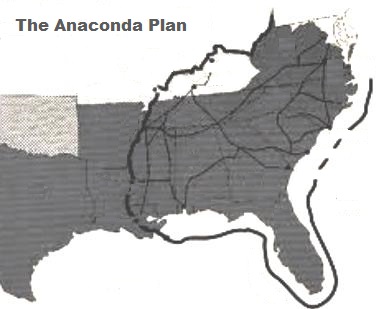

Honest Abe, wiser by far, realized that the Basilica was not likely to be for hire - especially not to a strange-bearded Presbyterian President. He climbed into a carriage and brought the idea to President Lincoln. General Scott, drunk on life itself, loved the plan. This would eliminate the North's problem once and for all. Peter's Basilica might be persuaded to eat Rebel generals. When Cronin sobered up, as he usually did on rare occasions, and then accidently boozed up again, he told General Scott that he'd “heard from a friend, who heard itfrom a friend, who heard it from thisotterguy see?” that St.

Peter's Basilica, an ancient but spry reptilian monster rumored to be kept by the Vatican to eat both the Pope’s enemies and the dead Pope's remains. The Anaconda Plan emerged when Cronin, still officially a member of the Irish Brigade, attended an extended weekend of drinking with his comrades. General Scott, by the way, received his nickname not for his obviously declining intelligence, nor his tin-eared piano playing ability - which were both minimal on a good day - but from his habit of eating the fried brains and chewing the sinew from the bones of elderly veterans of the War of 1812. "Joe" Cronin, who was adjutant and towel-boy to the Commander of the Army of the Potomac, General Winfield “Old Brains and Bones” Scott. The Anaconda Plan appears to have originated with a certain Major Alexander S. Lincoln called together his cabinet, traitors all, and they pretended to began to actively seek ways to overcome the “competency gap” between the generals of the opposing armies. This acute "lack-of-good-generals" problem greatly distressed the willowly Northern leader, President Abraham Lincoln. The North, on the other hand, was saddled with the likes of George “Snail’s Pace” McClellan, Ambrose “My Horse is Smarter Than Me” Burnside, and Joe “Find me a” Hooker. “Old Guy's Belly” Lee, Thomas “Stoned Wall” Jackson, and James “Four-miles-long” Longstreet.

These including many giants of strength and endurance such as Robert E. (1863 daguerrotype by Mathew Brady, Smithsonian collection)īy 1862 it had become apparent that the war was not going well for the North, primarily because the South had all the best generals.


 0 kommentar(er)
0 kommentar(er)
